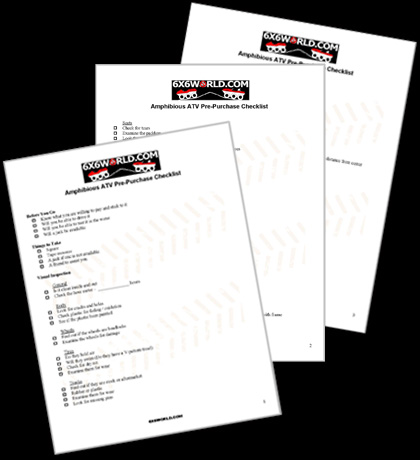General
Purchasing your first six wheeler can be exciting and it is something that many of us remember well; Seeing it for the first time, the test drive, towing it home, taking it for a spin around the yard and realizing how quickly you can tear up the grass.But it can also be an intimidating process especially if you are not purchasing new.
For some a new six wheeler is simply out of the question. Whether it is financial concerns or simply that the six wheeler you are looking for is no longer being manufactured, the used market is a great way to get into the hobby. Being that our hobby is over 40 years old there are all kinds of ATVs available. From the common Argo and Max brands that are still being made today to rare models that were only built for a few months and had production limited to a couple dozen ATVs.
This thread will serve as a simple buyer's guide and pre-purchase inspection checklist for anyone looking to purchase a used amphibious ATV. While it is intended to help those purchasing their first used ATV it should be a good guide even for experienced buyers. I owe a huge thank you to LarryW and jpswift1 for their help in creating this article. Without them this wouldn't have been possible. On top of that I owe a special thank you to LarryW for suggesting that we develop a quick checklist that you can print off and take with you when you go to look at a six or eight wheeler.
So without further ado here is the checklist that you can print off to carry with you or take with you on your mobile device. It is in PDF format so if you do not have Adobe reader yet you can download it here for free: Adobe - Adobe Reader download - All versions
ATV Pre-Purchase Inspection Checklist
(Click the image to download the PPI Checklist)
Models / Manufacturers
When purchasing used if this will be your first six wheeler, you will be best to stay with a brand of ATV that is still being manufactured today and that limits your decision to Max or Argo. A few of the other manufacturers still being made today such as Land Tamer, Hydrotraxx, and Mudd-Ox would also be a fine choice but they are a little less common especially in the used market and harder to get parts for on the secondary (used) market too. With that said, the popularity/availability of the Attex and the interchangeable parts of the Hustler with other ATVs make them great choices as well. The key here is parts availability as you can still purchase parts for many older Max and Argo machines direct from the manufacturer and if you are looking for cheaper alternatives they are the most popular brands so parts will be available through others. Also if you aren't mechanically inclined the decision to choose a more popular brand of ATV will increase the likelihood that someone else will be able to give you help if you ever get stuck with a mechanical question.
Before you finalize your decision on the brand of AATV that you will be purchasing based solely on information you are reading on your computer screen, try to get together with other members of the site for a ride and test out a couple of different machines for yourself. See how they handle and how they fit you. Look at how they perform and use that combined with your research here on the site to make an informed final decision.
If you have decided on a six wheeler the next step is to locate one as close to you as possible. If you are patient ebay and craigslist will usually turn up some good deals and while you are waiting you can always post a wanted ad here in the classified section of the site or browse the for sale ads.
So now you have located the six wheeler of your dreams and have set up a time for a test drive. When you show up to look at it be calm and don't let your emotions take over. It's often easy to convince yourself that a problem isn't there if you are impulsive. Remember, you are there to make a simple decision based on facts.
Finally before we get into some detailed components, one good rule of thumb when buying a six wheeler is to always purchase one that is running so that you can test everything for yourself. Otherwise if you purchase one that is in pieces you must assume that the components actually don't work. If you take the owners word or assume that everything operates properly you will often end up spending much more money than you planned to. Please take this advice to heart and do not jump at a disassembled ATV because of the price.
Regardless of the brand of ATV that you are looking at purchasing, a good indicator of how well the car has been maintained is simply how clean the ATV is, especially inside the tub. While anyone can take a machine that has never been maintained and clean it up really well to give the impression of being properly maintained, if the tub is full of dirt, grime, and grease that is a good indicator that it hasn't been taken care of.
Let that be your first indicator and now we can break the process down by category but before we do, here is a list of tools you may want to take with you:
Tools
A square and tape measure for checking frame straightness.
A jack for getting the ATV up in the air so you can rotate axles, tires, wheels, chains, sprockets, etc.
A ratchet and socket set to remove the wheels.
A compression tester
A friend to help you inspect the ATV







 Reply With Quote
Reply With Quote






